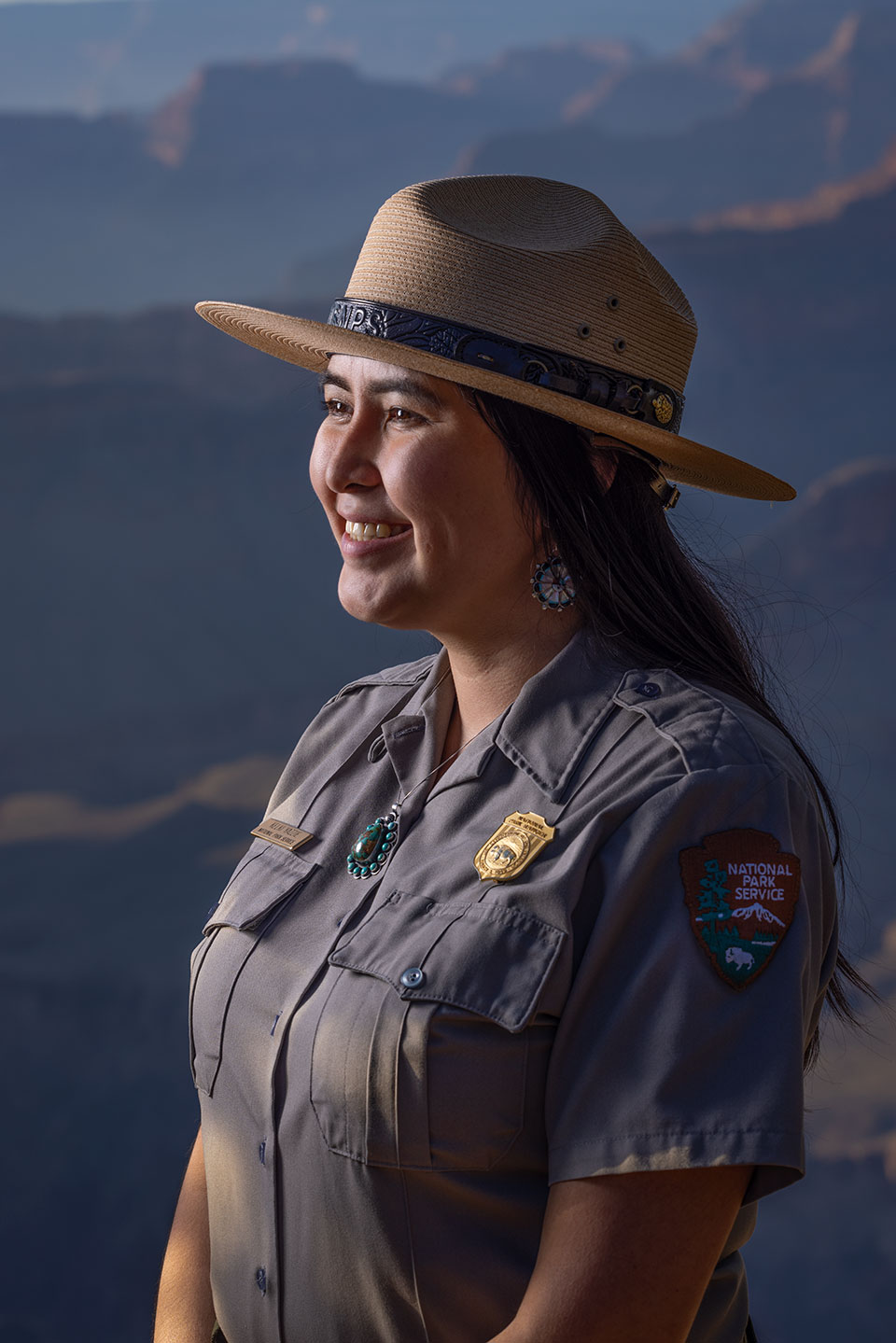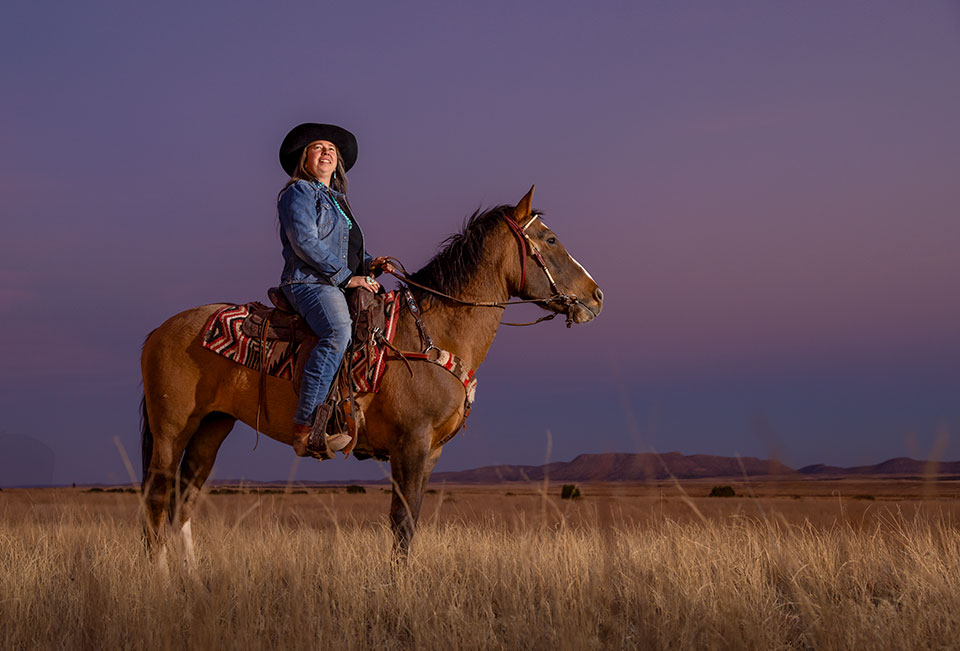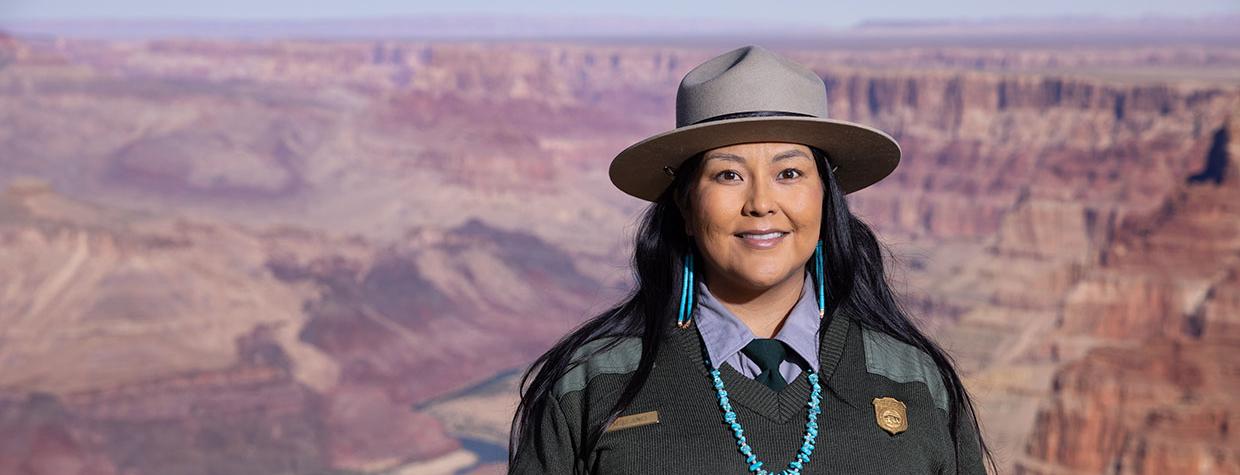Kelkiyana Yazzie was in fourth grade when her teacher took her class on a field trip to the South Rim of the Grand Canyon. No one mentioned that this was historically Native land — that this land and water were revered by the tribes that have always lived here. Instead, the 9-year-old Navajo students were told stories of intrepid Anglo pioneers who had “discovered” the area, explored and mapped it, developed the amenities that would one day bring millions of visitors to this American national park. As Yazzie, now an interpretive ranger at Grand Canyon National Park, says: “No one talked about Indigenous people.”
The lands now included in the national park are lands traditionally associated with 11 peoples who lived, hunted, farmed and held ceremonies there, including the Navajos (Diné), Havasupais, Hualapais and Hopis. These tribes have been here since time immemorial, and these people have the longest history, the greatest knowledge and the deepest cultural ties. Theirs is an understanding that comes from being birthed by this land.
Pushed off their ancestral lands by the creation of the national park more than a hundred years ago (as were other peoples for other national parks), these tribes, until recently, had no public acknowledgement that they are still here and have never left. Interpretive signs indicated only that the land in the park had been home to “prehistoric” peoples. Although the process of redefining whose land this is — and having conversations about how to move on — has now begun, the story of Native people of the Canyon also holds the sorrow of their displacement and the difficulties inherent in being the first of their communities to be agents of change. And the faces of this change are often those of Native women. “The park now recognizes Native peoples as the original but displaced stewards of the Grand Canyon and is working to center Indigenous perspectives in park management and interpretation,” Amanda Podmore, Grand Canyon director at Grand Canyon Trust, wrote in 2022. The trust, a nonprofit advocacy organization, is charged with safeguarding the wonders of the Canyon and the Colorado Plateau while supporting the rights of its Native peoples.
Interpretive signage has been changed to reflect a truer history. Hikers on Bright Angel Trail now find the oasis 4.5 miles from the trailhead rightfully called Havasupai Gardens instead of its previous name, Indian Garden. For uncountable years, the Havasupai people lived and farmed in this idyllic setting. The last of them, Thilwisa — known to European-Americans as “Captain Burro” — was forcibly removed by the National Park Service in 1928.
Native interpreters present to visitors a rightful view of what this land is and what the land itself means. But their numbers are low, which can elicit feelings of being tokenized. Being among the few is rarely easy, no matter how vital it is that somebody start. Sometimes, change comes from just doing the thing.
After graduating from college, Yazzie was hired as a seasonal ranger at Navajo National Monument, where she was a fourth-generation ranger, following her aunt, grandfather and great-grandfather. At the Canyon, she is asked daily, “How can I learn more about Natives?” Her programs, focused on the connections of the 11 tribes to the Canyon, bring Native voices to her audiences. She feels the necessity of providing non-Native visitors the facts of what happened here. “If we say it was nothing,” she says, “healing is never going to happen to us.”

The park’s 2019 centennial marked an effort to redefine the relationship between the park and the tribes. Importantly, Grand Canyon National Park now acknowledges whose land this is. As Sarana Riggs of Grand Canyon Trust wrote as the centennial approached: “For the 11 tribes that call the Canyon home, the park’s milestone is muddied with mistreatment. The creation of Grand Canyon National Park pushed the Canyon’s original inhabitants off their ancestral lands and excluded them from stewardship, management and economic opportunities in the park. But the centennial opens the door to redefine relationships, have tough conversations and bring new ideas to the table.”
“Our identity should be our qualification to work in these places,” Kelli Jones says, but her disappointment about the actual place of Natives in the park is palpable. Jones, who is Diné and an interpretive ranger at the Desert View area of the South Rim, is the first of her family to work for the Park Service.
Her concern is that Native people working in the park — some in the public’s presence, others in maintenance or housekeeping — remain unrecognized or tokenized. For all the centennial-timed focus on the theme of “We Are Still Here,” Jones feels not much has changed. Wearing her ranger uniform, she is recognized as part of the park. Visitors ask questions and value her thoughts, her knowledge, her experience. “But it’s hard being an interpreter,” she says, “because you want to talk about the changes here, but internally, I don’t feel it.”

She continues: “As a Native person, this uniform feels like a costume, an entitlement.” She feels it protecting her in ways other Natives are not — a feeling confirmed when, while out of uniform, she waved to a law enforcement officer she knew but went unrecognized, her wave unacknowledged.
“If these changes are really happening, why isn’t the Native community that has grown up here a resource included in the conversation?” Jones asks. “We wouldn’t be here today if it weren’t for the stories, songs and prayers of Grand Canyon. We want to share our stories. I want our Native youths to continue telling these stories. The Grand Canyon is our home, and we should be involved in the conversations of park management about tribal inclusion. We should be working here. About 35 percent of our community is Native, born and raised here. But only 7 percent work for the Park Service.
“There is a reason for me to be a park ranger: The creator brought me here. The Canyon is protecting us, for sure, but we need more. I want people to see we are capable. I want to feel I don’t need to be assimilated. For change to really happen, we need to be heard.”
Members of the tribes grow up with stories of place, plants, animals, sky and water. Who knows this world better than the people who live with these stories?
Ethnobotanist Carrie Cannon, an enrolled member of the Kiowa Tribe, was hired by the Hualapai Tribe in 2005. Through her work at the tribe’s Cultural Center, she launched a community-driven intergenerational program in which Hualapai elders teach land- and plant-based knowledge to the next generation, ensuring that centuries-old practices survive. Combining classroom teaching with harvesting field trips makes this a living practice linking the generations. For Cannon, the late Malinda Powskey — who spearheaded the Hualapai Ethnobotany Youth Project, a true keeper of the tribe’s
traditional knowledge of plants, land and language — exemplifies the power of, and necessity for, tradition.
Annual river trips from Lees Ferry 225 miles downriver to the tribe’s Diamond Creek are conducted by the Hualapai Department of Cultural Resources. For Cannon, these are opportunities to document vegetation changes in the Canyon since the construction of Glen Canyon Dam. “The environment is more controlled than existed before,” she says. “Plants now have an established riparian zone. The Inner Gorge has become far more riparian than it was.”
Elders share their observations and note traditional plants encountered along the 10-day trips. They often request stops in remote areas that hold memories or reinforce tribal connections to the Canyon. “Most passersby can’t fathom anybody ever lived there,” Cannon says.
Of course, most passersby aren’t Hualapai.
There is a Hopi woman I hoped to include in this story. But her work, her life and her huge variety of activities and engagements render her frequently on the move, which makes connecting with her hard. After a first conversation conducted over a bad phone connection, there was never again an opportunity within the timeframe of this story to get her OK on what I’d written about her. For me, that OK (or not) is essential.
But I believe it is no transgression to mention that — having been born, as all Hopis are, into a matrilineal society — she carries as a birthright the confidence that, for women, everything is possible. For the other women with whom I communicated, work associated with or in the Canyon offers a living, a life and, in a sense, reclamation of their rightful place in this geography. But it was in my conversation with the Hopi woman that I most clearly understood the power of home. Of place. Of generations.
Of history. Of centuries. When our bad phone connection cleared with her parting words, it seemed as if the very ether — or radio waves, or whatever it is that connects cellphones — understood the necessity of her words. The truth of them.
“I’m not a visitor,” she says. “I walk into the Grand Canyon like I own it. I feel like I belong there. It’s like walking into your own home.”
The Grand Canyon is her home. As it is the home of Kelkiyana Yazzie and Kelli Jones and the adopted home of Carrie Cannon. And home to all those people who have always been here. For the Indigenous people of the Canyon, it is as if the river itself flows through their veins.

